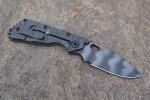Thank you, Wade. These pics are showing it pretty obvious (sp?).
So maybe I am overweighted and/or blind, when I call this liner thin. But I´d like to see the body of someone who´s calling it thick. Must be looking like Ghandi .
.
Hope, this was not too off topic.
So maybe I am overweighted and/or blind, when I call this liner thin. But I´d like to see the body of someone who´s calling it thick. Must be looking like Ghandi
Hope, this was not too off topic.




